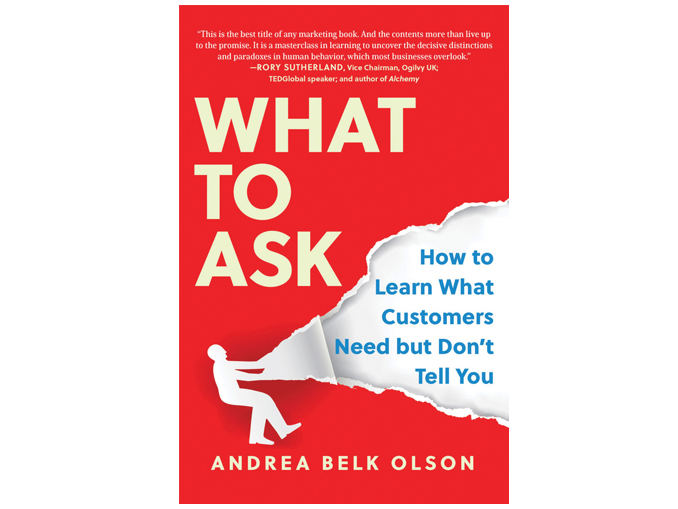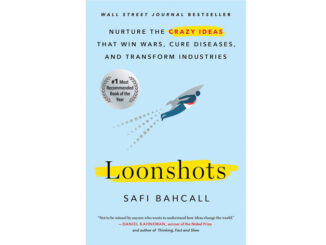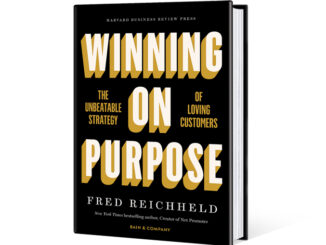Reviewed by Melanie B. Brewer, Santa Barbara Human Factors, Inc., Santa Barbara, California, melanie@sbhumanfactors.com
I picked up What to Ask: How to Learn What Customers Need but Don’t Tell You, by Andrea Belk Olson, because the title sounded like it might finally illuminate how to create the ultimate discussion guide. I imagined secret, insider knowledge and perfectly crafted questions with magical powers to elicit true customer needs. In actuality (shocker!) there is no magic. Instead, I found something possibly more interesting: a well-rounded examination of the many reasons companies struggle to innovate (or even talk to customers, much less get useful insights if they do). By understanding more about this, hopefully we can actually be more effective changemakers in advocating for research.
While she does indeed cover a line of questioning to elicit customer needs (more on this later), a lot of what interested me were the sections about why companies fail to embrace the very types of research most likely to result in differentiation and innovation. She describes some of the underlying reasons why companies look to big data as a “security blanket” and why they don’t prioritize getting the additional context that turns data into actual insights.
She points out that even when companies do go after insights, sometimes their goals and objectives are too fuzzy. I really liked the idea of the “Why and Wherefore Statement” that she introduces. This statement is an easy, almost formulaic way to define problem statements and research goals more robustly. It is a situation-and-approach model that highlights (1) what we know today, (2) our current assumptions on the root cause, and (3) the approach to validate or invalidate those assumptions. It’s a good mnemonic to make sure we stay focused on what matters most, and I’ve already used it to clarify research goals and help others do so.
Olson also provides a behavioral science framework for understanding why companies’ organizational mindsets are often close-minded. She describes seven frequently overlooked heuristics that are at play: Unconscious Affinity, Self-Confirmation, Conservatism, Fundamental Attribution Error, Mental Laziness, Tribal Loyalty, and Intuition. It’s certainly interesting to think of an organization having a nonrational mindset just like individual humans, and it opens the possibility of leveraging that knowledge to make them more open-minded to research.
I also appreciated the author’s no-nonsense approach to help companies become truly customer-centric through a variety of means, including leveraging corporate structure and culture. One simple, yet often overlooked step is for companies to go beyond the mission statement buzzwords and define what “customer centricity” actually means at their organization. Is it “keeping customer costs low, no matter what”? Or, is it “outstanding white glove customer service”? Those are two very different things! Her section titled “Kill Your Mission Statement” should be required reading at companies.
When it comes to the process of shifting mindsets and helping companies create and research new products, as described in the final third of the book, Olson focuses on a pragmatic approach. She has developed a “3W Ideation Process” in which she reframes the team’s mindset from internal needs to external opportunities, and helps them brainstorm surrounding contexts and obstacles, leading to a Wow Hypothesis. She validates this with an eight-question framework designed to elicit key influencers of customer perceptions and behaviors in a structured way that’s reproducible and easily compared, weighed, and sorted.
One point of criticism: although she is somewhat dismissive of jobs-to-be-done in earlier sections of the book, much of what she describes in the 3W approach could very well be described in terms of jobs.
Olson doesn’t pull any punches in this quick read (just under 150 pages) and keeps the reader engaged throughout. The book will have you nodding in agreement (or have your jaw dropping at her hilarious and occasionally profane ways of putting things). Her ideas and methods can help both internal and external researchers influence companies to really listen to their customers.
“We may agree to implement a survey here and there, but won’t commit to embedding a customer insight exploration mentality as a long-term part of the organization’s ecosystem and culture.”
—Book Excerpt




